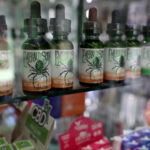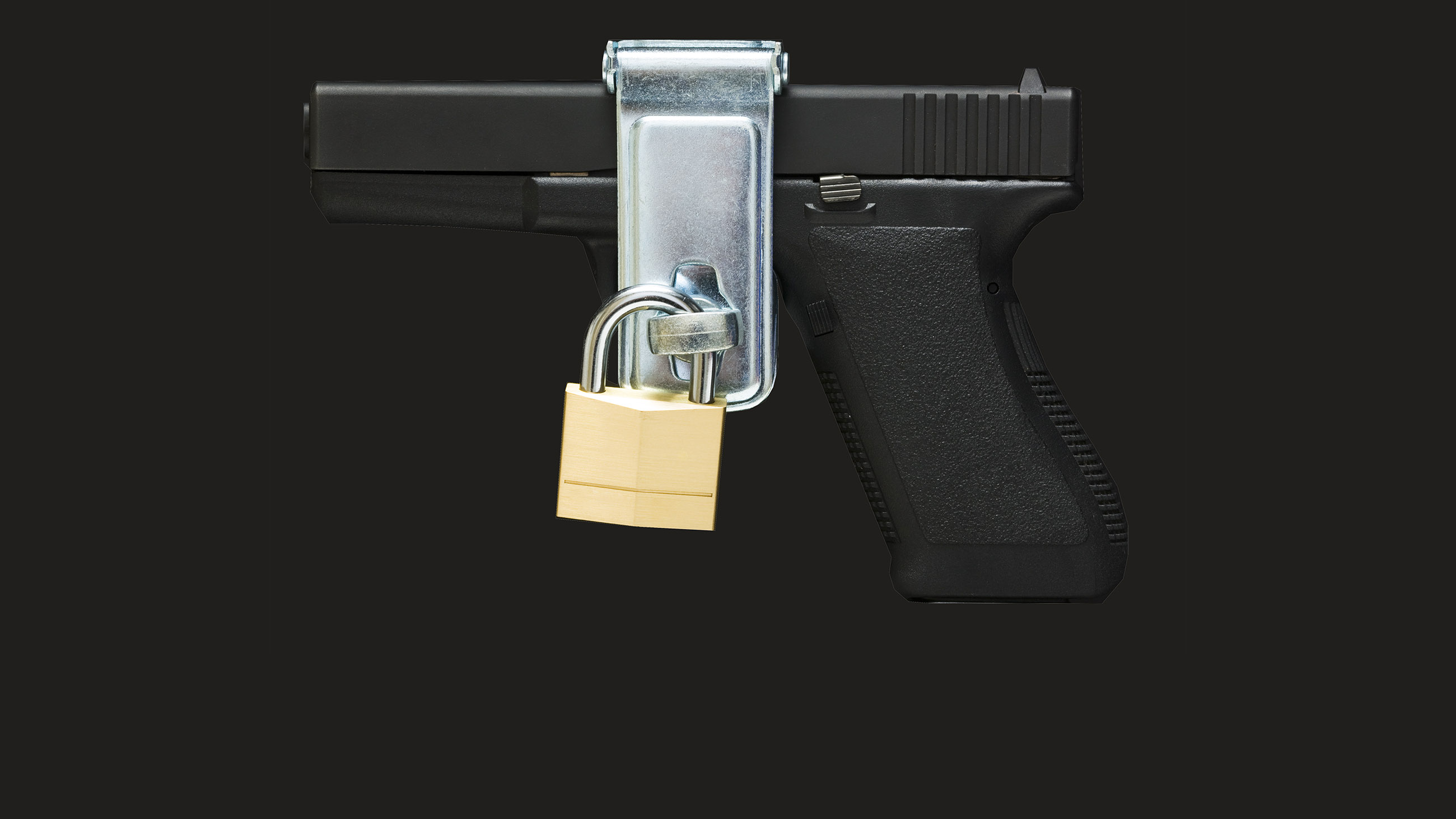One night last month in Red Boiling Springs, Tennessee, sheriff’s authorities allege that Lee Clark, 18, and Adam Cisneros, 19, broke into the local high school, managed to breach a locked safe in the office of the school resource officer, and made away with an AR-15 rifle and two bulletproof tactical vests.
When I told Dave Goetzinger, a writer and authority on gun storage, in Eugene, Oregon, about the incident, he wasn’t surprised. While authorities aren’t releasing information on the type of safe or how the teens got into it, Goetzinger said that many products sold to store or otherwise secure guns are not as robust as people might think. Indeed, some are so shoddily made that they can be opened with a gum wrapper.
MATTERS OF FACT: Exploring the intersection of science & society.
Goetzinger never imagined that he would need expertise in storing guns. But four years ago, he decided to get a handgun for personal protection. Ahead of that purchase, he bought a small handgun safe. “The moment I brought it home and took it out of the box, I suspected something was wrong,” said Goetzinger. “All I did was thump on it with a finger, and the thing sounded like an old-style coffee can.” Online, he found a video demonstrating how to break into his new “safe” by peeling off the adhesive keypad and poking a wire through the exposed holes to release the latch — a hack he could easily replicate. A closer look convinced him that many other products suffered from equally poor design. “I realized, hey guys, there’s a story here.”
Pursuing “a small piece of investigative journalism,” took Goetzinger down a rabbit hole into a largely unregulated industry. He discovered that magazines aimed at gun owners, supported by advertising for guns and related products, weren’t interested in identifying the makers of unsecure storage devices, so he did it himself. In 2015, Goetzinger created the website HandgunSafeResearch.com (which he is currently updating) where he posts the results of his investigations and videos of his security evaluation of products. He also posts videos on his YouTube channel and Amazon.com. He’s turned what he’s learned into a source of income — he now works as a consultant testing products and occasionally providing input for academic studies or gun policy development.
On the side, Goetzinger continues to “hack” gun storage devices, largely on his own dime, although he does accept donations and returns undamaged items. “I’ve been recycling the same $150 to $300 for a long time,” he said. His videos demonstrate that it’s disturbingly easy to break into many nominally secure gun safes. He’s shown them to be prone to jiggling the lock with a coffee stir stick, a piece of tape, or other household item; entering random digits on a keypad until you hit the right combination; or simply bumping the container in just the right way so it pops open.
Even so, many of the products Goetzinger tests meet requirements established by California law, now the de facto national standards for gun safe security. Those standards were inadequate when they were established nearly two decades ago, he argues, and have become dangerously outdated since. “The most frightening discovery I made about this mess is that defective firearm safety products go into circulation because of the legal machinery that was put in place to protect us,” he said.
Regardless of whether you find the American penchant for gun ownership laudable or scary, it’s clear that too many firearms wind up in the wrong hands. Last year, a comprehensive study of emergency room records revealed that more than 282,500 Americans — including nearly 8,000 younger than 15 — were treated for firearm-related injuries between 2009 to 2012. More than 22,000 people died of their injuries. The researchers point out that their data doesn’t include people who die before they could be treated in the ER. For example, based on data from death certificates, a recent report from the U.S. Centers for Disease Control and Prevention found that nearly 40,000 people in the U.S. died from gunshot wounds in 2017 — 60 percent took their own life.
While the nation bickers over the causes of gun violence and politicians appear stuck in an endless loop of thoughts and prayers, the one point upon which nearly everyone can agree is the need to keep firearms away from children, thieves, or people at risk of harming themselves or others. Since 2005, federal law has required (with some exceptions) that licensed importers, manufacturers, and dealers who sell or transfer a handgun provide the buyer with a device to secure or store the gun.
Even in my home state of Texas, where a slew of new laws aimed at relaxing already-loose regulations on gun ownership went into effect this month, the most recent budget included $1 million for a public safety campaign about firearm storage.
But, according to Goetzinger, “the assumption that locking up guns in various ways will reduce gun violence rests upon a faulty belief that these products — handgun safes and gun locks — are adequate for securing guns.” His research provides overwhelming evidence that this just isn’t the case for many commonly sold products, he said. “Furthermore, if you consider the failure of lawmakers to collaborate effectively with security specialists and engineers to draft proper firearm safety device standards, what reason does anyone have to assume that lawmakers are competent to address the multitude of other issues surrounding guns?”
In one demonstration video, a gun vault is foiled with a gum wrapper.
To get an idea of the market for these devices, I looked online and visited sporting goods and discount stores as well as shops that specialize in guns and safes. I found a huge variety of options.
The least expensive devices are simple locks that fasten around the trigger or secure a cable that runs through the barrel or action of the gun to keep it from firing. The next level of security is a locking container or cabinet, priced anywhere from $25 to $350. At the high end are real safes, constructed with thick heavy-duty steel walls and sturdy bolts to secure the door, which start at around $200, but can cost $10,000 or more for large, floor-standing models.
The federal government hasn’t set mandatory standards for any of these devices. However, a handful of states maintain a list of approved products or require them to meet certain standards. In 2002, California established the most comprehensive requirements for firearm safety devices manufactured or sold in the state. Such products must meet standards set forth by the California Department of Justice or, in the case of safes, by the safety certification organization Underwriters Laboratories. Because it would be impractical to make separate products just for California, many devices on the market have undergone the process to become “California-approved.”
Goetzinger is most concerned with the category of firearm safety devices, which encompass most of the products I saw on the shelves. “When lawmakers were designing these standards, they were attempting to devise a comprehensive testing process to evaluate too many disparate products — from lockboxes or handgun safes, to a few gun cabinets to cable locks and trigger locks,” he said. (Although manufacturers use “safe” and “vault” as marketing terms to describe what are essentially lockboxes, California puts true safes in a separate category with more stringent requirements for construction and security.)
The main problem, according to Goetzinger, is that lawmakers in California based the testing specifications for firearm safety devices, at least in part, on simple padlock requirements set in 1997 by ASTM International, a global standards organization that develops and publishes voluntary technical standards for a wide range of products. They are inadequate, Goetzinger said, for lockboxes and other storage containers. “They don’t address mechanical requirements relating to the material, material strength, the electronic locking mechanism if there is one,” he said. “And there really aren’t any standards that address forced or covert entry.”
The California testing standard, which is specifically tied to the 1997 ASTM padlock guidelines and has not been substantially revised since, is also outdated. This means that while access technology has evolved dramatically over the last several decades — from biometric scanners that can recognize fingerprints and radio-frequency identification (RFID) devices that provide touch-free access, to Bluetooth capabilities that work with your smartphone — the California testing requirements have not.
Other voluntary standards are more current and thorough than California’s, although I found fewer products that meet them. Underwriters Laboratories has a range of tougher standards for safes based on security and fire protection, for example. And ASTM International has established separate standards for locking devices meant to keep a gun from being used and for containers that should resist break-in by kids younger than 12.
“The younger kids — the 7-, 8-, and 9-year-olds, yes, you can protect them with something very basic,” said Ralph DiMicco, who for more than 30 years owned Riley’s Sport Shop, one of the largest gun stores in New Hampshire. “But as you get up in age, ability, and imagination then you need to get more serious.” DiMicco helped found the Gun Shop Project, which provides education on suicide prevention through gun stores and firing ranges. He told me a tragic, cautionary story about one of his customers, a state trooper, who kept his guns in a lower-end metal cabinet. “His son got to drinking one day while his parents were away, broke into the safe, and took his own life,” he said.
Foiling another lockbox, this time with a screwdriver and a paperclip.
Authorities said that they arrested the two young men in Red Boiling Springs less than 12 hours after the school break-in and found the stolen rifle and vests buried in Clark’s backyard.
The hundreds of other incidents of gun theft that occur each day in the U.S. are often not so handily resolved. An estimated 380,000 firearms are stolen in 250,000 incidents each year according to a nationally representative survey of 1,600 gun owners conducted by researchers at the Harvard T.H. Chan School of Public Health and the Department of Health Sciences at Northeastern University. And despite any qualms about the quality of gun locks and lockers, the study suggests that those who use them are less likely to be the victims of gun theft. “Though little is known about the circumstances of these thefts, it is reasonable to expect that, all else equal, firearms that are locked up are less likely to be stolen than those that are stored less safely,” said Deborah Azrael, associate director of the Harvard Youth Violence Prevention Center and one of the study authors.
Firearm injury is also the second leading cause of injury-related death for children between the ages of 1 and 17. Just increasing the number of households where all guns are locked up by 20 percent could cut firearm deaths in people 19 and younger by approximately one-third, according to a recent study by the Harvard and Northeastern team. Yet, the group estimated that 4.6 million American children live in households where one or more guns are stored loaded and unlocked — more than double the number in 2002.
“The best way to be safe is not to have a gun in your house,” said Azrael. But, she said, it’s hard for people to accept the evidence a gun is far more likely to injure a friend or family member than some future assailant or intruder. The challenge is that we are asking people to store their gun in a way that they perceive will take them longer to get to it for self-defense, said Azrael. “And the number of people who think they need a gun for self-defense is increasing.”
But while organizations concerned with shooting sports, public health and safety, and gun control are all understandably focused on convincing the public to lock up their guns, I didn’t find any of those groups clamoring for stronger rules on how the gun locks and gun safes are made.
One bright spot is that the federal Consumer Product Safety Commission (CPSC) has asked the ASTM to update its standards for firearm locking devices and youth-resistant containers. The first set of changes went into place last June and will roll out over the next two years, said Mike Lukas, a supply-chain consultant who is a member of those ASTM subcommittees. “This revision with the assistance of the CPSC will result in more robust testing requirements, updated testing apparatus, and the addition of testing related to new technologies emerging into the marketplace,” he said.
In response to an interview request from Undark, the California Department of Justice, which sets and enforces the state’s gun storage and security regulations, simply said the agency was “unable to provide legal advice or analysis.”
Still, Lukas shared that he considered the California law to now be less thorough and current than the ASTM standards. He also suggested that it was odd for California lawmakers to peg the regulation to an ASTM standard with a specific date — in this case, the 1997 ASTM standards for padlocks. Typically, when ASTM standards are referenced in state and federal regulations, the date is not included, so that the regulations are updated as ASTM standards evolve and improve.
For his part, Goetzinger said he’d like to see gun locks and safes earn more rigorous scrutiny. Too many, he said, are cheap imports from China with little in the way of reliability or durability. “If we’re going to have a second amendment and preserve the right to own guns here in the United States, I don’t think it’s an infringement on gun rights if we require gun safety products to be manufactured here to strict standards,” he said. Those standards ought to be created at the federal level, he added — not only with the input of engineers, but also security experts. If we acknowledge that guns are deadly weapons and we want to keep them out of the wrong hands, then gun ownership imposes a responsibility, he said. “Any safe, no matter how small, that is used for securing a firearm must offer real, substantial resistance to forced entry and covert entry.”
Even when lawmakers have shown interest in Goetzinger’s campaign for stricter regulation, he said they often lack competence.
“I don’t think people know how to respond to a whole lot of administrative machinery,” he said. “It’s just grinding on, unobserved.”
Teresa Carr is an award-winning, Texas-based journalist with a background in both science and writing. She is a former Consumer Reports editor and writer, and a 2018 Knight Science Journalism Fellow at MIT. She writes the Matters of Fact column for Undark.











Comments are automatically closed one year after article publication. Archived comments are below.
I was searching about concealed gun storage and land up on your blog. Your details are astute and to the point. How can I follow of your blog. I love to share gratitude for your efforts.
There is a statement that Unintentional injury death by firearm is the second cause of death in juveniles. It is not. Look it up and fact check these claims.
We ordered a six foot steel modular safe from Zanotti Armor (Waterloo, Iowa). It arrives on a freight pallet. You assemble the components in your closet, basement or other area. Once assembled it was much larger than the doorway to our walk-in closet. High security engineering and combination lock unlike the cheapo big box store safes. You get what you pay for.
I see comments like “a gun is far more likely to injure a friend or family member than some future assailant or intruder” all the time. To re-phrase it, however, would be “a gun is far more likely to injure someone the owner routinely comes in contact with than someone they may never come in contact with”. Which itself seems pretty obvious.
It’s kinda like the “most accidents happen with a few miles of the driver’s house” thing. Sounds ominous, but in reality is really just “most accidents happen in the are the driver spends the most time”.
Comments like the former really call into question the credibility of the speaker.
That said, gun safes/locks/etc are not meant to be Fort Knox. They are meant to prevent quick, unexpected, and accidental access. And they generally provide that. Even a full standing gun “safe” is pretty easily breached by someone with a Sawzall and enough time. If your endgame is total security I have bad news for you….
You suggest passing a law that makes the victim of the theft of a firearm a felon him/her self? This is unbelievable tunnel vision aimed at punishing gun owners and thereby discouraging gun ownership. If you use that reasoning let’s make you a felon if your car, bicycle, baseball bat, tire iron, etc. etc. is stolen and used in a crime.
There are several ways that can easily increase security:
2. Pass a law that the previous owner of a stolen weapon is partially culpable for crimes committed with that weapon. This would be a felony, but if reported to the police before the crime, it becomes a misdemeanour with a stiff fine.
3. Allow insurance companies to insure fines. If your safe passes their requirements, you get a lower rate.
1. Ammunition is not stored in the same cabinet, but is in a different one. This doesn’t stop someone from buying more ammo at the local walmart, but it’s one more hoop that interferes with spur of the moment action.
4. Trigger locks are much harder to deal with generally than padlocks. No access for bolt cutters. You at least have to drill out the cylinder. Depending on the quality of the lock, this may be a few minutes to a long time. Again, not foolproof, but another hoop.
So Sherwood, if a stolen car is used in a crime, should the person the car was stolen from be responsible for the crime too?
If you lose your coat and that coat is used during a crime, should you be responsible for the crime?
This is an idiotic statement.
Can I add a link to this site to my site?